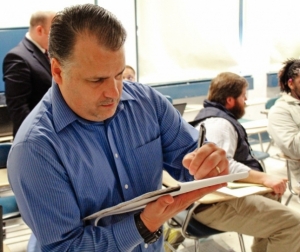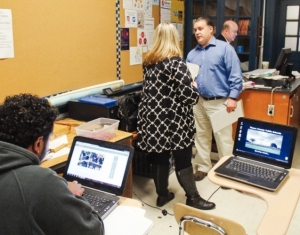County teachers begin 'instructional rounds'
By Phyllis Moore
Published in News on December 27, 2016 9:57 AM

Submitted photo
Tom Garrou, Goldsboro High School English teacher, takes notes during a classroom observation as one of the "instructional rounds" being conducted as part of Wayne County Public Schools' efforts to improve learning and teaching techniques at the district's low-performing schools.

Submitted photo
Ashley Horne, left, Goldsboro High School science teacher, talks with Tom Garrou, GHS English teacher, during an instructional round in colleague Adam Clark's English classroom.
Low-performing schools in Wayne County are getting a shot in the arm from a practice prompted by the medical profession, officials say.
Marcia Manning, hired earlier in the school year as innovative programs coordinator for Wayne County Public Schools, said the practice of "instructional rounds" was introduced recently at Goldsboro High School and Dillard Middle schools.
"It's modeled after doctors doing rounds, where they communicate with each other, to go into patients' rooms and then get together and talk about what they saw and help diagnose and improve patient care through communication with each other," she said. "It actually started at Harvard through an educator whose father was a physician."
In May, the N.C. Board of Education approved the district's "Restart Model" application for GHS. The designation gave the school system more flexibility in structuring its calendar and how it delivers education at the low-performing school. The school's schedule was aligned to that of Wayne Community College, affording students the opportunity to attend classes and earn college credits like their counterparts around the county.
Robert Yelverton, a graduate of GHS named principal in February, called this school year a "fresh start" for students and teachers alike.
Ms. Manning's background included being a former middle and high school principal at an early college before working with N.C. New Schools, coordinating services for 29 schools across the state.
"My job is really to connect what's going on in some of the high performing schools with schools that are really wanting to implement those strategies," she said.
She began the year focusing on the district's two innovative high schools that have proven success for the district -- Wayne Early/Middle College and Wayne School of Engineering, broadening the concept to incorporate GHS, DMS and Eastern Wayne High School.
"Because our district has two high schools that are high performing schools, the principals were very interested in learning from those teachers," she said. "In the fall, Wayne Early Middle hosted a study visit and the principals from the other schools invited four teachers from their staffs to do a study visit."
During the initial visit, teachers received an overview of the WEMCH program and an invitation to participate in an exchange program of sorts.
"We had several teachers at Wayne Early Middle that did the pre-round, where a teacher shares with you, 'This is what I'm teaching today, here's what I'd like you to pay attention to,'" Ms. Manning said.
Teachers observed things like the presentation and teaching style and interaction with students. They were also allowed to interact with students and ask questions.
Afterward, during a post-round, the guests offered up feedback in a factual and student-centered way. They are encouraged to use "I noticed" and "I wondered" commentary, she said.
"A big component is it's not evaluated," Ms. Manning said. "We really discourage the visiting teacher from saying anything positive or negative. We want it to be very fact-based from what they saw from the students."
The effort is designed to be helpful for those in a profession that can sometimes be a solitary one, she added.
"The purpose is to give the host teacher feedback, but it always ends up going both ways," she said. "I'm finding that many of the teachers here are extremely receptive to innovative teaching techniques. They really are interested in collaborating with other teachers.
"They want to engage students. They want the teaching to be really relevant to students' lives. We also want students to feel like we value them."
The concept is also being implemented at Dillard, where the district introduced a "school within a school" concept this year in the form of Tiger Academy.
In that case, students have also been incorporated into the exchange process of the instructional rounds.
"We want the students to see what high-level, student-to-student collaboration looks like," she said. "There's a big difference between true collaboration and putting four desks together and working on a worksheet."
The interesting twist taken at Tiger Academy was that students got to observe sixth- and seventh-graders at Wayne School of Engineering. They were given clipboards and tasked with paying attention to how their counterparts collaborated and what they were saying.
"(Dillard students) went back to their own classrooms and told other students about what they saw," she said, adding that a similar exercise was conducted with eighth-graders, visiting ninth-grade classrooms at Wayne Early Middle.
"All of this wraps into the idea of what do your really high quality instructors look like?" Ms. Manning said. "What are teachers doing in engaging students in their classrooms and what are students doing in student-engaged classrooms?"
Yelverton said that while still in the beginning stages, it is an opportunity for his school to do things differently, and better.
"It's just another tool in the toolbox to allow our teachers to be more professional in their craft," he said. "We're trying to use all the opportunities that we have to strengthen the teachers that we have."
Two GHS English teachers, Adam Clark and Tom Garrou, have gone through the observation process, calling the instructional rounds a paradigm shift.
"Even from some unassuming sources, I have learned things and I have put them in action," Garrou said.
"I think something that's too often lost on students, they forget that we're learning, too," added Clark, who has been at GHS for three years.
The colleagues said they were impressed with how students reacted to their tag team approach -- taking the opportunity to ask questions of both educators and observing their cooperative roles.
"At the very beginning of this, we were told that everything that's done is with the idea to better the students," Garrou said. "The easiest decision we make is for the betterment of the students. With that in mind, we were just all over this idea."
Garrou, who has spent all of his six years teaching at GHS, said he is aware that the widespread perception of the school has been less than stellar. He praised the administration and staff, asking for patience from the community as the school's strengths come to light.
"A degree of patience needs to be levied toward what we're doing and just helping us see it through," he said. "There's probably a ton more positives going on than what's being tweeted out there."
All the schools in the district are not the same, Ms. Manning said, but ultimately the goal is that every single one provides the highest quality of education to students.
"More kids apply to innovative schools than can be accepted. There's obviously a demand for students in our innovative classrooms. If kids that wanted to get in can't get in, then we owe it to them to provide that kind of education," she said. "We would love to have a district where parents feel like they get a high quality education everywhere."
